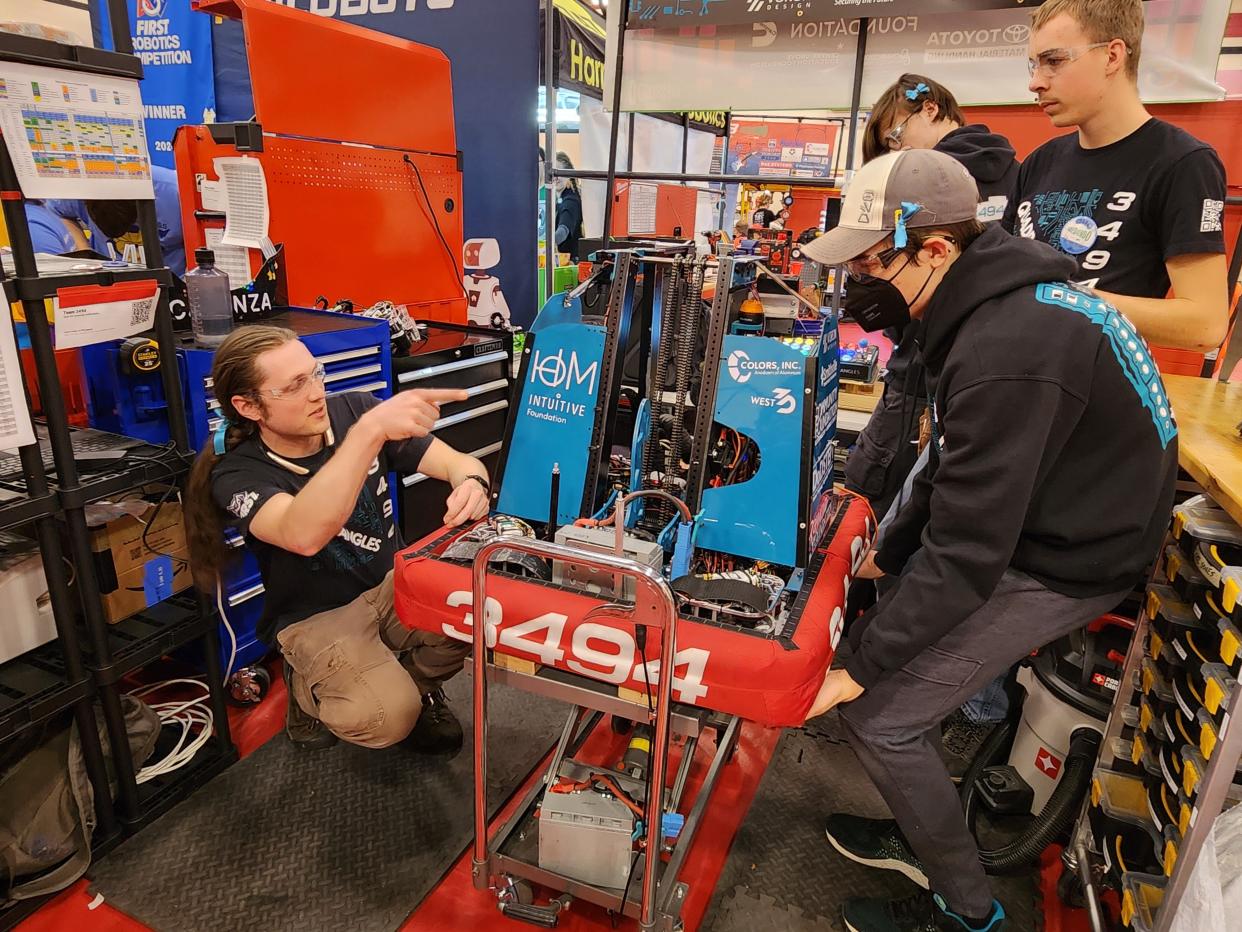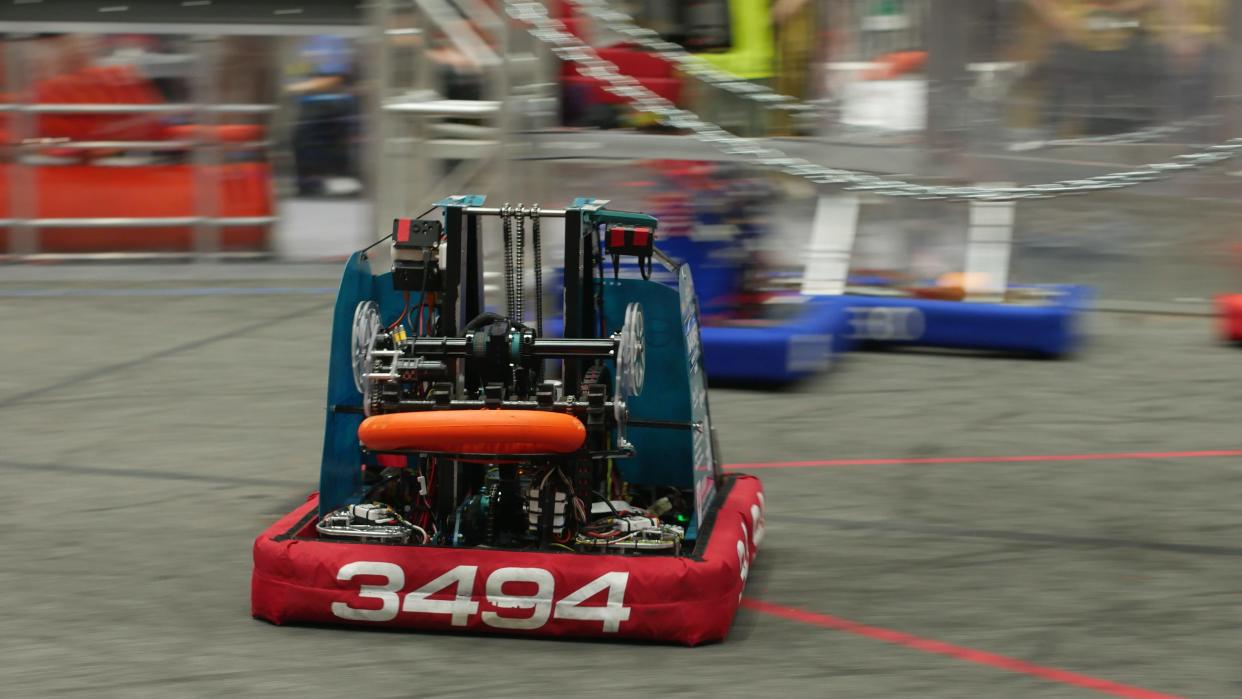Bloomington South robotics team headed to world championships in Houston
F.I.R.S.T. Indiana Robotics held its state championship on the weekend of April 5-7 at Jefferson High School in Lafayette, Indiana. Students, their families, and educators from across the state packed the school's indoor basketball court to watch robots designed and built by high school students compete in high-intensity team sports. The only team from Bloomington and Monroe County at last weekend’s events triumphed as a qualifying team for the F.I.R.S.T. world championship in Houston on April 17-20.
F.I.R.S.T., or For Inspiration and Recognition of Science and Technology, is an international nonprofit organization founded in 1989 by inventor Dean Kamen in order to prepare PreK-12 students for careers in STEM through team-based robotics programs. 38 teams from across the state were present at the state championships last weekend. The one team from Monroe County, The Quadrangles (team number 3494), is based out of Bloomington High School South and played in a total of 12 matches.

The team consists of 19 high school students and 11 mentors. Among the mentors are the team's two founding members, Chris Hacker and Cindy Kvale, who shared the story of the team's founding in 2011. Kvale attempted to create the team in 2004, but found that it was not a sustainable project at the time. She partnered with Hacker in 2010, and through his connections at Naval Surface Warfare Center Crane, they were able to secure the necessary funding to formally create the team in 2011.
The Quadrangles saw many generations of students enter during their high school years and leave for college as new recruits replaced them. Some alumni have come back as mentors while studying in college to guide younger members. Emerson Bessler, a mechanical engineering student at Purdue, kept his ties with the Quadrangles as a mentor.
"I'm proud of these kids, it's pretty awesome to see what they're able to accomplish," Bessler said. "Being an alumni, and then going on to be a mentor…the perspective it brings on seeing how they grow is really cool, and something I never appreciated as a student because I was just living it."
Every year a new game is invented six weeks prior to the championships, forcing teams to create a new robot design and game strategy under a tight deadline. This makes it impossible to re-use robots from previous games as they would have been designed for different purposes.
Every round the robots are randomly assigned to color-coded teams of three, which are called "alliances.”
The randomized selection makes each robot alternatively cooperate with and compete against the others, but each robot's respective team maintains a score of its own. The object of this year's music-themed tournament is to pick up orange rings called "notes" and place them into goals around the court.

There are four kinds of goals — amps, speakers, and stages, plus hidden trap doors — which can be scored for points. The most valuable goal is the stage, a tall triangular structure with openings for the rings. Chains are strung across each side of the structure for robots equipped with arm-like lever mechanisms to lift themselves up and drop rings into the opening, like a robotic slam dunk.
In a separate basketball court are the "pits", or stations where each team has the opportunity to test, repair, and maintain their robot before sending it out for another match. The high-contact action of the machines often result in damages that mechanics can have as long as one hour to repair or as little as 15 minutes before their next match. Some of the Quadrangles' robots have been damaged in past events, but this year they were hardly scratched. They received the Quality Award on Sunday for finishing unscathed.
The Quadrangles are composed of several specialized sub-teams. There are specialized teams for wiring, electrical, programming, design, fabrication, and many others. Some specialties not directly related to the construction of the robot itself also have their dedicated team as well, such as the business and marketing team.
"We run our team like it's a business," Kvale said. Members have the option of cross-training by moving from one sub-team into the next or participating in more than one, making the Quadrangles a team of dynamic and innovative technicians.
Dianna Ochoa-Lynch, a senior at Bloomington High School South, has had a similarly dynamic trajectory. Ochoa-Lynch was interested in engineering since at least the fourth grade — "for as long as I can remember," she said — but when the Quadrangles visited her middle school to demonstrate one of their robots, she knew she wanted to get involved in robotics.

She learned Autodesk Fusion as a high school freshman during the Coronavirus pandemic and joined the Quadrangles in her sophomore year. Now she is the lead designer and assistant engineer for her team. Ochoa-Lynch said she hasn't committed to a college just yet, but she has been accepted into the MIT class of 2028 and plans to visit soon. Her long-term career goals include research on soft robotics — "robots which are flexy," she describes — and the development of soft robotics exoskeletons to aid human capability.
The Quadrangles emerged in second place out of the 38 participating teams. Ranking in the top 11, the Quadrangles are qualified to compete in the world championships in Houston. The last time the team participated in the world championship was in 2017, years before any current members of the team joined.
Alex von Hoene, a mentor of the team since 2019, described the state championship as a "rollercoaster."
"We went in knowing that we had done well, but knowing that the odds were not great," he said. "People were predicting that we might lose half of our matches and maybe win half of our matches … and then we started doing really well."
After a strong start, he describes the disappointment of being eliminated from the tournament after losing two semifinal matches in a row. There was little to do but to "watch and wait, and then the tournament ended, and then the stands got quiet as they largely emptied out of teams that knew they weren't going and were going home, and the teams that knew they were going, or were pretty sure that they were going … were just left to sit and wait for 15 minutes or so while headquarters doublechecked all the numbers … and then we made it!"
Following the state championship, the Quadrangles returned to their workshop in Indiana University's Multidisciplinary Engineering and Sciences Hall to make their final preparations before departing for Houston. Their robot sustained almost no damage at all during the state championship, leaving them with no major problems to address apart from general maintenance.
This article originally appeared on The Herald-Times: Bloomington South robotics team qualifies for FIRST world championship
